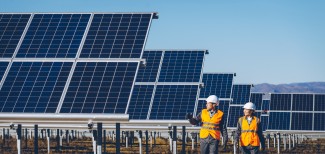Many low-income individuals and families are finding it increasingly difficult to rent apartments (see here and here), but energy efficiency and solar energy can help save affordable multifamily housing. Our new report, Our Powers Combined: Energy Efficiency and Solar in Affordable Multifamily Buildings, shows how building owners are combining energy efficiency upgrades and rooftop solar systems to reduce energy use and lower their energy bills. These upgrades enable housing providers to devote more resources to preserving and expanding affordable housing, while also improving the health and well-being of building residents.
Combining energy efficiency and solar leads to positive results
Foundation Communities, an affordable housing provider in Austin, Texas, has substantially reduced the energy costs of its multifamily buildings by combining energy efficiency upgrades with rooftop solar systems. In 2012, the organization installed several such improvements at its Arbor Terrace property including ENERGY STAR®–compliant lamps, heat pump air conditioners equipped with occupancy sensors, and metal roofing to increase reflectivity and decrease the building’s need for cooling. Foundation Communities also installed a rooftop solar system along with water conservation measures at the property. Today, the building’s utility costs are one-quarter less than a typical multifamily property.
However projects like these are not without their challenges. Foundation Communities has found that the performance of energy efficiency and solar equipment is largely dependent on whether staff and residents understand how to properly use and maintain it. Training and educating those living and working in multifamily buildings on the use of newer energy technologies can improve building energy performance.
Affordable multifamily energy efficiency and solar projects can also present substantial upfront planning and development costs for housing providers. To overcome this hurdle, the National Housing Trust Enterprise Preservation Corporation (NHT-Enterprise) is installing both energy efficiency and solar resources across all of its buildings in Washington, DC. Taking this portfolio-wide approach to reducing energy use has allowed the organization to save on upfront project costs, aggregate energy cost savings, and leverage savings to preserve more affordable housing.
Affordable housing providers cannot go it alone
Affordable multifamily housing providers need supportive policies and programs to help them integrate energy efficiency and solar resources. For example, building owners often rely on incentives to make investments that will reduce their energy costs. The US Department of Housing and Urban Development (HUD) offers lower mortgage insurance premiums for green energy-efficient housing, and some state housing finance agencies (HFAs) incentivize or require that projects pursuing Low-Income Housing Tax Credits reduce a building’s energy use.
When Connecticut set out to renovate its affordable State-Sponsored Housing Portfolio, the state realized that renovation projects undervalued energy savings absent specific requirements or incentives to do so. This led the state’s housing agencies, utilities, and Green Bank to maximize energy savings in affordable multifamily buildings by coordinating and streamlining the delivery of their incentive and financing programs.
Local and state governments can also support these projects by setting and holding themselves accountable to energy efficiency and climate change goals that reduce the energy burdens of their low-income and minority residents. Many states require that energy efficiency and solar incentive programs benefit low-income and underserved communities. California requires utilities to allocate a portion of greenhouse gas auction proceeds to benefit these communities, providing critical support for the state’s Low-Income Weatherization Program for Multifamily (LIWP-MF). This program has successfully tackled the challenge of split incentives between owners and renters. Under most circumstances, owners are not able to justify projects that reduce residents’ energy costs because there is little or no return for investors. LIWP-MF has overcome this challenge by offering high incentives to building owners for energy efficiency upgrades and solar systems that benefit renters. Thus far, the program has reduced participating affordable multifamily buildings’ energy use by an average of 44% and is projected to save more than $48 million in utility bill costs and avoid 120,000 metric tons of CO2 equivalent over the next 15 years.
Where we go from here
While our report covers only a handful of projects and programs, they offer valuable lessons for housing providers, policymakers, program administrators, and private investors. Innovative and supportive policies at the federal, state, and local levels can encourage building owners to make energy efficiency upgrades and install rooftop solar projects that together cut energy use, lower energy bills, and reduce harmful greenhouse gas emissions. These policies and projects can help preserve and expand affordable housing in a market that offers few such options for low-income families and individuals.
Join us for a webinar at 1:00 p.m. EDT on Tuesday, May 15, or at ACEEE’s 2018 Energy Efficiency Finance Forum, as we discuss the report’s key findings and further explore how energy efficiency and solar energy can help save affordable multifamily housing.


